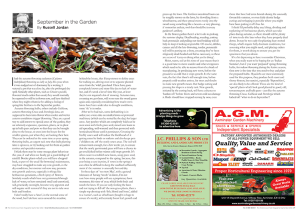
I had the autumn flowering cyclamen (Cyclamen hederifolium) flowering as early as July, this year, when it was nudged out of dormancy by a wetting, I watered a pot that was close by, after the prolonged dry spell. Similarly other plants, such as Crinum x powellii, flowered much earlier than usual, they would normally be expected to still be in flower now, and have finished when they might otherwise be adding a feeling of spring-like freshness to the September garden.
Autumn flowering bulbs, others include Colchicum, autumn flowering Crocus and Sternbergia lutea, are supposed to burst into flower when cooler and wetter autumn conditions trigger blooming. They are a good way to add interest to special areas of the garden, they are relatively expensive, specimen, plants, or to plant up in bulb pans and pots so that they can be brought close to the house, or even into the house for the smaller species, just when they are looking their best. They can be ordered at the same time as your spring flowering bulbs, an urgent task now that bulb planting time is upon us, or try looking out for them in garden centres and specialist nurseries.
I think there may be some strange plant behaviour this year, if and when we finally get a good dollop of rainfall. Border plants which you will have chopped back, as part of the usual ‘de-browning’ maintenance, may have struggled to make any new growth, in the dry conditions, but moister soil now may promote new growth and even, especially in things like herbaceous geraniums, a fresh spray of flowers. Similarly weeds which have not germinated through lack of water, or have remained small and unnoticed, will, practically overnight, become very apparent and will require swift removal if they are not to take over beds and borders.
I don’t really have a ‘lawn’, in the normal sense of the word, but I do have areas around the meadow, behind the house, that I keep mown to define areas for walking on, driving over or to separate planted areas from the ‘wild’ grassland. These have gone completely brown and straw-like due to lack of water but, and it’s saved a lot of time this year, at least they’ve not required a lot of mowing. Autumn rains, assuming we get them, will soon turn the sward green again and, especially considering how much stress lawns have been under due to drought conditions, some ‘tlc’ is in order.
After we’ve had rain, some dethatching is in order; use a wire rake on smaller lawns or powered machinery (which can be rented by the day) for larger areas. Any patches which are completely bald can be over sown with fresh grass seed, mixed into loam to aid spreading, well-watered and then protected with horticultural fleece until it germinates. Covering the freshly sown seed will reduce the likelihood of it getting eaten be birds or rodents and also keeps pets / children etc. off the newly sown areas. The soil will remain warm enough, for a few weeks yet, to ensure that the newly germinated grass will have a chance to get established before winter cold stops growth. It’s often easier to establish new lawns, using grass seed, in the autumn, compared to the spring, because, this year being a case in point, if sown in the spring it can often be difficult to keep the seedbed sufficiently moist if the summer is unusually hot and dry.
In these days of ‘no mow May’, with a general tolerance of having ‘weeds’ in lawns, I’m not sure how many people will use a proprietary lawn treatment, this time of year, which both feeds and weeds the lawn. If you are only feeding the lawn and not trying to kill off the non-grass plants, then a simple top dressing with ‘fish, blood and bone’, added to a ‘carrier’, such as sifted loam (bought in bags to ensure it’s sterile), will certainly boost leaf growth and green up the lawn. The fertiliser inoculated loam can be roughly strewn on the lawn, by shovelling from a wheelbarrow, and then spread more evenly into the sward using something like a besom—a very pleasing, if somewhat archaic, tool that should be in every gardener’s artillery.
In the flower garden there’s a lot to do to prolong the summer display. Deadheading, weeding, cutting back perennials and pulling out tired bedding will all help to keep it looking respectable. Of course, dahlias, cannas and all the late-flowering, tender, perennials will still be putting on a show, assuming they’ve been religiously dead-headed and fed as necessary, so these are a case of ‘carry on doing what you’re doing’.
Moist, warm, soil at this time of year means that it is a good time to move conifer and other evergreens which need to be able to recover from the shock of transplanting, by producing new roots, before the ground is so cold that it stops growth. In the same vein, the fact that there’s still enough time, before properly cold weather arrives, for trees and shrubs to make new growth means that hedge cutting and pruning for shape is a timely task. New growth, initiated by the cutting back, will have a chance to ‘harden off’ before frosts and severe cold can damage it. Birds should have stopped nesting by now, even those that have had extra broods during the unusually favourable summer, so even fairly drastic hedge cutting and reshaping is possible where you might have been putting it off thus far.
I think I’d probably delay any lifting, dividing and replanting of herbaceous plants, which can take place during autumn, as there should still be plenty of time to do this later when they have properly died down. It may be too early for planting bare-rooted things, which require fully dormant conditions, but assessing what you might need, and placing orders for them, is worth doing to ensure you get the specimens that you desire.
It’s a bit depressing to have to consider Christmas, when you really want to be hoping for an ‘Indian Summer’, but if you want ‘prepared’ spring flowering bulbs, for indoor flowering during the festive season, then now is the time that you need to buy and plant the prepared bulbs. Hyacinths are most commonly used for this purpose, they produce both scent and showy flowers, but narcissi, especially ‘Paperwhites’, are also likely to be offered. These are the kind of ‘special’ plants which look good planted in good, old, terracotta pots and bulb pans—just like the autumn flowering Crocus, Colchicum and Sternbergia which kicked off ‘what to do in September’!



